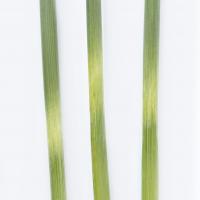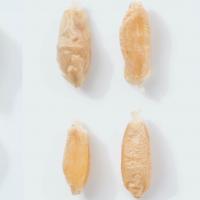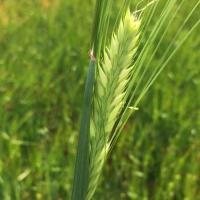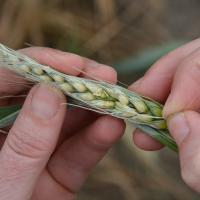What to look for in wheat
Paddock
- Symptoms may not be obvious until 5-10 days after a frost.
- Heads on affected areas have a dull appearance that becomes paler as frosted tissue dies.
- At crop maturity, severely frosted areas remain green longer as its likely the plants have reshot to compensate for the damage.
- Severely frosted crops crop have a dirty appearance at harvest due to blackened heads, stems and discoloured leaves.
Plant
Leaves, stems, florets and grain can all be affected by frost. In some circumstances, a plant may suffer both stem, flowering and grain frost, especially if a series of frost events occurs. The nature of frost damage depends upon the plant development stage at which the frost occurs.
Head emergence (Z31-45)
When the head is developing and emerging from the boot, cold air or water is caught next to the flag leaf, or travels down the awns into the boot, freezing the sensitive tissue. This can cause pollen abortion, resulting in undeveloped florets or bleached florets (Image 1).
Stem
Stem frost occurs when a small amount of water settles inside the leaf sheath above the penultimate node and adjacent developing tissue of the boot. This is likely to happen if a light shower of rain occurs at dusk and then a frost follows. The damaged section of the stem then moves up, as the peduncle continues to elongate with flowering. Frost damage of the peduncle will have a pale green ring. Physical damage can be seen as a flattened peduncle or felt by running a finger down the stem.
Flowering
A frost event during flowering can cause sterilisation of the floret, as the pollen, ovary or both are damaged. The result is that the head will be underdeveloped and/or have bleached florets with no grain developed in that floret.
- Healthy anthers before flowering are green to yellow in colour. After flowering (anthesis), they are yellow turning white with age.
- Frost affected anthers are white and distorted (banana shaped) turning a dull brown in colour (Image 3).
- Heathy ovaries are bright white in colour when squeezed. As the grain develops it turns green in colour and begins to fill the floret.
- Frost affected ovaries turn a dull brown and are spongy when squeezed. They begin to shrivel as no grain develops (Image 4).
- A healthy stigma is white and feathery until after pollination.
- A frost affected stigma takes on a crumpled appearance (Image 4).
Grain
Frosted grain at the milk stage is white eventually turning brown, with a crimped appearance. It is usually spongy when squeezed and does not exude milk/dough. Frosted grain at the dough stage is shrivelled and creased along the long axis, rather like a pair of pliers has crimped the grain in the middle (Image 5).
What to look for in barley
Flowering occurs close to the boot, which offers protection to anthers against frost exposure. As in wheat, when a frost occurs it can cause sterile florets leading to absence of grain. Floret sterility can be determine by raising the head so the sun is behind it. Light comes through florets where grain is absent (Image 6). As grain develops, the florets remain closed.
Stem frost in barley is not as common as in wheat but when it does occur it has similar symptoms.
What to look for in oats
Oats are susceptible to frost at stem, pre-flowering, flowering and grain filling albeit less than wheat and barley. Florets hang downwards allowing warm air to be trapped inside, protecting them from frost.
Sterility of florets sometimes occurs as the pannicle is emerging (Image 7).











